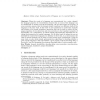Free Online Productivity Tools
i2Speak
i2Symbol
i2OCR
iTex2Img
iWeb2Print
iWeb2Shot
i2Type
iPdf2Split
iPdf2Merge
i2Bopomofo
i2Arabic
i2Style
i2Image
i2PDF
iLatex2Rtf
Sci2ools
JUCS
2002
2002
Error-Correction, and Finite-Delay Decodability
: When the words of a language are communicated via a noisy channel, the language property of error-detection ensures that no word of the language can be transformed to another word of the language. On the other hand, the property of error-correction ensures that the channel cannot transform two different words of the language to the same word. In this work we use transducers to model noisy channels and consider a few simple transducer operations that can be used to reduce the language properties of error-detection and error-correction to the transducer property of functionality. As a consequence, we obtain simple polynomial-time algorithms for deciding these properties for regular languages. On the other hand the properties are not decidable for context-free languages. In addition we show that, in a certain sense, the class of rational channels can be used to model various error combinations. Using the same tools, we also obtain simple polynomial-time algorithms for deciding whether a...
| Added | 22 Dec 2010 |
| Updated | 22 Dec 2010 |
| Type | Journal |
| Year | 2002 |
| Where | JUCS |
| Authors | Stavros Konstantinidis |
Comments (0)

